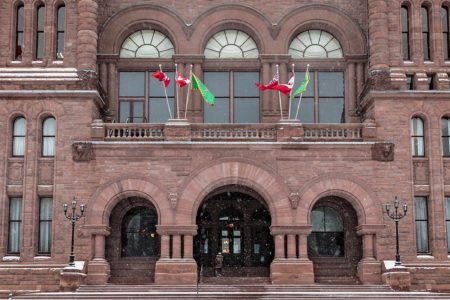
This paper leaves aside the question of whether electoral reform is needed and instead considers whether reform is even possible in Canada. As many observers have pointed out, the biggest obstacle to reform is that the political party with the power to initiate change— the governing party—almost certainly will have been rewarded by the quirks of the existing system. Nothing is likely to turn advocates of proportional representation into defenders of the status quo faster than seeing their party win an unexpectedly large parliamentary majority on the basis of 40 per cent of the popular vote.
This conventional wisdom, while containing a good deal of truth, would be more convincing if it weren’t for the fact that several established and stable liberal democracies— notably New Zealand, Italy, Japan and the United Kingdom (at both the sub- and supra-national levels)—have made changes to their electoral systems in recent years. In these countries, a way was found to encourage reluctant political leaders to embrace reform. It is therefore instructive to review these cases briefly and to identify the conditions that facilitated change in order to see what lessons they offer advocates of electoral reform in Canada. Following this review, we will propose a process for reform that includes a referendum to ratify change, but embeds the referendum in a larger mechanism of citizen participation.
In Japan in the 1980s the Recruit Scandal, which involved widespread financial corruption, damaged the careers of many leading Japanese politicians. But much of the blame for the scandal (named after the Recruit Corporation). fell on the electoral system itself and the factionalism and hyper-competitiveness that it bred. In 1988, in the scandal’s aftermath, an advisory committee was set up to examine various aspects of the electoral system. In 1990, it produced a report that recommended a mixed electoral system similar to the one found in Germany.
The scandal produced a large number of defections from the Liberal Democratic Party (LDP) that had governed Japan uninterrupted since 1955. These deserters formed a variety of new parties, many with the words “new” and “clean” in their names, all of which featured electoral reform as a prominent plank in their democratic reform agendas. It is certainly possible that they made these promises not out of a genuine commitment to reform but to avoid the electoral retribution that was likely to befall the LDP. This fact, however, highlights the importance of genuine popular interest in electoral reform: It compels self-interested parties to take up this gauntlet. The new parties did very well in the subsequent elections in 1993, while the LDP dropped 10 points to 37 per cent of the vote. After several unsuccessful attempts at putting together a package that would satisfy all coalition members, in 1994 a compromise was finally reached that had three-fifths of the seats elected through first-past-the-post, and the remaining two-fifths elected using proportional representation in 11 regional blocks. That compromise was enacted into law in 1994 and the first election under the new rules took place in 1996. Post-election negotiations resulted in a coalition government made up of the Liberal Democrats, the Social Democrats and Sakigake (one of the new parties formed before the 1993 election.)
In New Zealand, the Labour Party won more votes than the National Party in the 1978 and 1981 elections, but on both occasions the National Party formed the government. In these two elections, the third party, Social Credit, received first 16 per cent and then 20 per cent of the national vote, but won just one, and then two seats. Although this very high disproportionality clearly put the issue of the electoral system on the agenda for the supporters of the Social Credit, it was the back-to-back losses for Labour that incited it to include in its election platform a promise to appoint a Royal Commission that would consider electoral reform. When Labour won in 1984, it made good on its promise. The Royal Commission examined a wide range of issues and eventually recommended the adoption of a German-style mixed system. As is all too common in such cases, the Labour government then took no action. During the subsequent election campaign of 1987, it promised to hold a binding referendum on the issue in its next mandate, but this promise was not honoured. The opposition National Party then attempted to capitalize on Labour’s broken promise by making its own promise to hold a referendum, even though the opposition leader, James Bolger, personally opposed PR (see Mr. Bolger’s discussion of New Zealand’s experience on pp. 25-30).
When the National Party was elected in 1990, it largely followed through on its promise, holding an advisory referendum that included two questions: a first asking whether voters wished to retain the existing first-past-the-post system, and a second asking which of four reform options voters would prefer, if reform were to occur. Voters overwhelming rejected the existing system (85 per cent), and a substantial majority (70 per cent) chose the Royal Commission’s recommendation of a mixed system, a result that highlights the importance of a recommendation from a credible, neutral source. Fifty-five per cent of voters turned out to cast a ballot, a respectable result considering that the referendum was only advisory and no simultaneous election was being held. The results of the 1992 advisory referendum prompted a binding 1993 referendum that asked voters to choose between the new system and the status quo. Voters opted for change by a relatively close margin (54 to 46 per cent), with 85 per cent of the electorate turning out to vote. One reason for the closeness of the result was that opponents of the changes, backed by big business, were able to outspend proponents by about 10 to one.
The New Zealand process is instructive. The Royal Commission’s legitimacy put pressure on the government to act and provided the public with a credible voice to which they could turn for a trusted recommendation. The process also featured what can be described as cascading referenda, in which the voters were asked three separate questions (one including four options) over a period of 14 months. On the face of it, voters made reasonable and informed choices on the usually arcane topic of electoral reform.
In Italy, electoral reform was facilitated by the referendum abrogativo, which provides Italian voters with an opportunity to overturn legislation that has been passed by Parliament. In order to initiate a referendum, 500,000 signatures must be collected within a period of 90 days. In the wake of widespread public belief that the country’s political parties were rife with corruption and unable to reform themselves, a petition drive in 1991 succeeded in provoking a referendum to strike down parts of the existing electoral law. The initial drive for a referendum was led in part by sitting deputies who did not like the existing system—a fact that highlights how the referendum abrogativo allows dissident parliamentarians to circumvent government leaders.
In the 1991 referendum, 96 per cent of voters approved the change. The turnout was 62 per cent. The result was a severe reprimand to the existing system and a strong mandate for change.
Parliament, however, responded by making only small changes to the existing system. The 1992 election therefore featured continued debate on electoral reform, and for the first time voters were offered the possibility of voting for a party list where all members were committed to more ambitious changes to the electoral system. Following the election, in which the party committed to reform did quite well, a second petition drive was launched and qualified easily. In the ensuing referendum in 1993, 83 per cent of voters expressed support for radical reforms to the electoral system (the turnout was 77 per cent). This time, Parliament felt compelled to act.
Several points about the Italian experience stand out. First, the referenda passed so overwhelmingly in part because the public attributed the corruption within the parties in large part to the electoral system itself. Second, the presence of the referendum abrogativo—an institution which allows voters to strike down existing legislation but not draft their own—was key. The referendum allows those outside the government and the legislature to initiate change. It also produces an ongoing dialogue between the general public, those sponsoring the referenda, existing politicians, the courts (which rule on the legality of referendum questions) and Parliament, which, as we have seen, responded to the first referendum by passing moderate reforms, only to be rebuffed again in a second referendum. Finally, because the party elites (or partiocratzia) were in such wide disrepute, many of them felt compelled to make proposals to democratize aspects of the political system, even if they did not want to abandon the country’s existing form of PR. For example, Bruno Craxi, the leader of the Socialist Party, called for the direct election of the President. Such proposals stimulated debate about the overall need for change and by so doing gave the issue of electoral reform a higher profile than it might otherwise have had.
The UK currently offers a classic example of how a party’s interest in electoral reform can cool once it finds itself in office with a healthy parliamentary majority. After its election victory in 1997, the Labour government appointed an Independent Commission on the Voting System, but after the commission’s report it backed away from its pledge to hold a referendum on proportional representation. Electoral reform nevertheless has occurred in the UK since 1997. The new assemblies in Scotland and Wales are elected under a form of PR, and so are the UK’s representatives to the European Parliament. Admittedly in the case of Scotland and Wales, it was not a case of changing the electoral system but of putting a new system in place where none previously existed—which highlights the importance of opportunities afforded by rare moments of regime change or constitutional reform. In the case of elections to the European Parliament, the switch to PR can be viewed as a concession that Labour chose to make in order to gain credibility with reformers within the party and among the Liberal Democrats, the third-largest party in the House of Commons.
The Liberal Democrats have played the key role in advancing the debate on electoral reform in the UK. Like many third parties, they are heavily penalized under the first-past-the-post system. Unlike smaller parties in Canada, however, they not only favour PR but have vigorously championed the cause and state categorically that a referendum on the issue is the sine qua non of their participation in any coalition government. As some recent election campaigns have at one stage or another been close enough to make a hung parliament a realistic outcome, the media have tended to pick up on the issue of electoral reform, pressuring the Labour and Tory leadership to take a stand. And Labour’s desire to continue its more or less cooperative relationship with the Liberal Democrats prompted it to renew its interest in the question of electoral reform in the run-up to this June’s election.
In the absence of a major constitutional or regime change (such as Quebec secession or the creation of new assemblies in Scotland and Wales), the factors that persuade politicians to accept change are quite easy to identify but difficult to reproduce on demand.
The Italian and Japanese systems were beset by major scandals or institutional paralysis that could be credibly blamed on the electoral system. In both cases, existing parties began to disintegrate over issues of corruption and the need for democratic reform. The result was the emergence of new and legitimate parties within the legislature making credible commitments to change.
Thus it appears that unpopular political leaders, recessions, or general declines in confidence in the government are not sufficient conditions for change. Moreover, an even more serious crisis of confidence may not be sufficient if it is attributed to one individual or party: The crisis of confidence must be severe, must be attributable to a deeper problem linked with the electoral system, must force parties to take a stand in favour of reform, and, in the process, must provoke the public to become interested in the issue.
In Japan and Italy, electoral reform was linked with other issues of democratic reform. This too appears to be an enabling condition for reform. By itself, electoral reform can be a technical and arcane issue. But when presented as part of a broader package of democratic reforms, and linked to such other issues as campaign finance reform, it is more likely to capture the public’s interest and support.
In New Zealand, Labour Prime Minister David Lange’s promise to hold a binding referendum was made inadvertently during a campaign debate, while Japanese Prime Ministers Noboru Takeshita and Sosuke Uno acted in the heat of scandal to initiate political reform and appoint an advisory committee on the electoral system. In both countries, political leaders later tried to downplay their commitments. But the act of badgering a leader during a crisis or an election campaign into promising some kind of process was an important first step in securing reform in both countries.
Debates about electoral reform led by political parties are fueled by self-interest: There is, not surprisingly, a close correlation between parties’ positions on the need for change and their expected benefit from any new system. Governing parties usually get a bonus in first-past-the-post systems, as do regionally concentrated smaller parties, while smaller parties with widely distributed support suffer most. Disproportionality and unfairness occur in many countries, however, and yet do not trigger electoral reform. But in New Zealand, the fact that one of the two major parties was consistently punished by the electoral system was an important factor contributing to change. By the time the Labour Party formed a government in 1984, many of its leading figures had concluded that reform would be in the party’s interest. The Liberal Party of Quebec is similarly penalized by that province’s electoral system: In both 1994 and 1998, the party received about as many votes as the Parti Québécois but lost the elections (in terms of seats) by wide margins. When they next form a government, the Quebec Liberals might also see that enacting reform is in their long-term interest, something that is true of few major parties.
Change can take time. In Japan and New Zealand, it took five to seven years from the time of the formation of a commission until new legislation. It took under four years in Italy but this was due to the use of the citizens’ initiative which struck down the existing legislation and forced the government to act. During these lengthy processes, much can go wrong to derail progress. Even so, the reform agenda can be advanced if certain parties and political leaders make clear public commitments to reform. In Canada, it is therefore very important that parties which stand to benefit from PR—such as the NDP or the Conservatives—make unequivocal promises regarding electoral reform, and make a referendum on reform the sine qua non of their participation in any future minority government. Activists should insist that these promises be highlighted rather than buried in election platforms, and they should remain vigilant and active within political parties to keep these issues alive, especially after the parties come to government. Leaders of smaller parties should raise the issue in televised leaders debates and try to force other parties to respond. As we saw in the Japanese case, it is only when a large coalition of opposition parties got together, all with ironclad commitments to reform and a shared belief that the public is interested and expects these commitments to be honored, that the systemic inertia against change can be overcome.
One other option is available to reformers, at least in the provinces of Saskatchewan and BC. In these provinces, citizens have the power to initiate referendums on issues of their choice. While the existing rules make it difficult to successfully launch a referendum (something that no doubt explains why none has been held to date) the possibility of a citizen-initiated referendum on electoral reform does nevertheless exist. In exceptional circumstances—for instance, should one provincial party win every seat in the legislature— the public may be sufficiently mobilized to make the gathering of the requisite number of signatures a very real possibility, particularly with the help of party organizations that have been penalized by the existing system. As in the Italian case, change is more likely to come from outside established political parties than from within. And once changes occur at the provincial level, changes to the federal system become more plausible.
Suppose a Canadian government—either of its own accord or under pressure—did decide to initiate a process of change, what should this process look like? We argue that it should have three goals in addition to change itself: to inform the public; to focus the debate and narrow the choices; and to provide opportunities for citizen participation in setting the agenda, defining the options, and making decisions. While it is important that voters make the final choice of how (if at all) to change the electoral system, the referendum must be just one part of a larger package of public consultation.
The process should begin with the formation of a commission of inquiry, charged with examining options for electoral reform and the likely effects of each option in the Canadian context. We argue however that the commission of inquiry should itself be embedded within a larger and more participatory citizens’ forum on electoral reform. The citizen’s forum would be charged with two tasks. The first would be debating and approving the mandate of the commission of inquiry; the second, debating its findings and amending and approving the options to be put to the people in a referendum on electoral reform. As was the case with the Australian people’s convention on the future of the monarchy, the citizens’ forum would be made up of both appointed and elected members. All registered political parties (including those currently without representation in parliament) would be allowed to appoint a certain number of members, while elected members would be chosen by the public, either by postal ballots or via the Internet. This would ensure that many of the key voices in the debate about electoral reform—notably those from minor parties that hold few or no seats in the House of Commons—had some input.
Why a citizens’ forum? Greater and more meaningful citizen participation in the making of key political decisions is both a public priority and an important feature of a maturing democracy. It is not enough to allow citizens to testify before public commissions or even to vote in referendums. Public hearings allow for an airing of views but provide citizens with no chance to participate in the deliberations that shape the commission’s recommendations. And if citizens are called upon to vote on options that they have had no say in shaping, they can end up feeling more frustrated with the political process than they were before the referendum.
A citizens’ forum would help to educate the public about the issue of electoral reform. This process of public education must start long before a referendum campaign is held; if not, risk-averse voters are likely to reject change simply for want of information. Public awareness and interest in electoral reform would be raised initially when elections for members of the citizen’s forum are held. Citizens could inform themselves further by tuning into televised coverage and web casts of the forum’s proceedings. And they would learn even more by noting the stands taken on the issue by leading public figures participating in the forum.
A citizen’s forum would enhance the credibility of the process in two key ways. First, it would help to make it less partisan. The involvement of the forum in shaping the commission’s mandate and its recommendations would make it less likely that the process would be seen as being driven by the governing party with a view to advancing its own interests. Second, the process would be seen as less exclusively “top-down” in nature. While most of the forum members would be political leaders of one sort or another, public involvement throughout the process would discourage the public from dismissing the proposal as merely an elite project to benefit those in power.
The question of the mandate of the commission of inquiry is especially important. It is not surprising that the Independent Commission in the UK recommended a mild form of PR—a mixed system in which at least 80 per cent of MPs would continue to be elected in individual constituencies on a first-past-the-post basis—given that under its terms of reference it had to choose a system that combined the objective of “broad proportionality” with those of “the need for stable Government” and “the maintenance of a link between MPs and geographical constituencies.” Whether or not a future Canadian commission will favour one or another form of PR will also depend on its initial terms of reference. Under our proposal, the government would suggest the commission’s mandate, but that mandate would be debated, amended and approved by the citizens’ forum before the commission began its work. This would help to ensure that the government could not overtly rig the commission’s mandate in a way that favoured its own interests.
The second function of the citizens’ forum would be to debate the commission’s findings and amend and approve its recommendation for a referendum question. Essentially, this means adding a step between the release of the commission’s report and the approval of a referendum question by parliament. Again, the rationale is clear: First, it would ensure that a wider range of interests had some input into the selection of those options that would be put to the public in a referendum, thus making it somewhat more difficult for the government and larger parties to write a referendum question that offered voters only a “soft” option for reform. Secondly, it would help to ensure that the commission’s findings received more public attention and were subject to greater public discussion. Third, when recommendations for reform emerged from these highly public processes, it would be more difficult for governments to escape action.
Finally, we turn to the referendum itself. Throughout this paper we have taken it as a given that no serious change can be made to the electoral system without its being approved by referendum. But one referendum may not be enough. Unless there is a more or less unanimous view that only one type of new electoral system is appropriate for Canada, the government should be prepared to hold more than one vote, so that voters could choose from a “short list” of different options. For instance, the public could be given the option of choosing between the status quo, the option recommended by the commission and approved by the majority of the citizens’ forum, and an option recommended by the government. The model here is the sequential referendums on the future of Newfoundland held in the late 1940s: the first round was used to eliminate the least popular of three options, and the winning option was determined in the second round.
This is not the same as a “never-endum” in which voters are asked to revisit the same question. Instead, we take citizens seriously as responsible decision-makers. Differences between contending electoral systems are profound and important. Canada would look very different if elections were conducted under a mixed system or under the single transferable vote. There is no reason why Canadian citizens should not be given the chance to decide which type of new system they prefer, rather than being given a single “take it or leave it” option for reform. To do otherwise risks reproducing the result of the Australian referendum on the country’s head of state, where a reformist public voted for the status quo simply because it did not like the only option for change that it was offered.
Photo: Shutterstock









